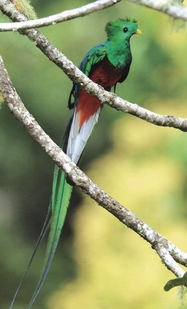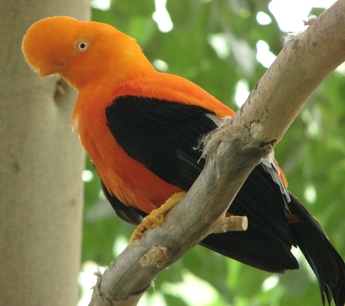|
1. In ic centlamantli, ïntöcä Töltëcah: iuh mihtoa, yehhuäntin achto nemicoh in nicän tlälli ïpan in mihtoa Mexihcatlälpan, in Chichimëcatlälpan. | First, those named the Tolteca: according to what people say, they first came to live here in the land called land of the Mexica, land of the Chichimeca.
|
|
2. Auh quëzqui.tzon.xihuitl nenqueh in ömpa Tölläntzinco. In ca nelli ömpa nenqueh, miyac ïnnëzca2 qui.tlälih.t.ëhua.queh2: | And for several four-hundreds of years they dwelt in the vicinity of Tollantzinco (the Venerable Töllän). They really lived there, they left many of their traces which they had fashioned.
|
|
3. in ömpa quichïuhqueh in ïnteöpan catca , in ïtöcä huapalcalli. In äxcän ca cah ca mani; tël in ic ahhuel polihui, ca tetl ca texcalli. | In that area they made what was their temple; its name was “house of beams.” Today it stands; it exists, considering that it is indestructible; for it is rock, stone.
|
|
4. Niman ömpa yahqueh, ömpa nemitoh, niman ömpa nenqueh in ätoyatënco in Xicocotitlan, in äxcan motöcäyötia Töllän. | Then there they went; they went to live, to dwell there on the banks of a river at Xicocotitlan (“place of the bumblebee”), now called Töllän (Tula).
|
|
5. In ca nelli ömpa cemonoca5 , ömpa nenqueh, ca nö miyac in ïnnëzca in quichïuhqueh, auh in quicäuhtëhuaqueh: | Because they truly resided there together, they dwelt there, so also many are their traces which they produced and left behind
|
|
6. in äxcän ca onoc, ca itto, in ahmo quitzonquïxtihtiyahqueh6 , in mihtoa cöhuätlaquetzalli …; | [one thing that] is there today, which is to be seen, which they did not finish [is] the so-called serpent column …;
|
|
7. auh ca itto in Töltëca-tepëtl, auh ca onoc in Toltëca-tzacualli, in tlatïlli, auh in Töltëca-tlaquïlli; | And the Tolteca mountain is to be seen; and the Tolteca pyramids, the mounds, and the surfacing of Tolteca [temples].
|
|
8. auh onoc in Töltëca-tlapalcatl itto, auh äno in tlällan in Töltëca-caxitl, in Töltëca-cömitl; auh miyacpa äno in tlällan in Töltëca-cözcatl, in mäcuextli in mähuiztic, in chälchihuitl, in teöxihuitl, in quetzalitztli. | And Tolteca fabrics are there to be seen, and tolteca bowls in the earth, Tolteca pots are taken from the earth. And many times there are taken from the earth Tolteca jewels: awesome arm bands, turquoise, emerald-green jade.
|
|
9. Auh iniqueh in Töltëcah, ca mo-Chichimëca-ihtoah, ahtle huel cencamatl ïntöcä: zan ïntech män, ïntech quïz in ïntöcä, in ïnnemiliz, in ïntlachïhual in ic töltëcah, mihmatinih. | And these Tolteca called themselves Chichimeca. There [was] no single word for them. Their name is taken from —it comes from— their manner of life, the works of their artisans [töltëcah], their way of dong things.
|
|
10. Mochi cualli, mochi yëctli, mochi mihmati. Mochi mähuiztic in ïntlachïhual. Cualli in ïncal, tla.xiuh.zalö.li , tlahtlahchictli , tlahtlaquïlli, huel mähuiztic. | The Tolteca were beautiful, all pure, all wise. Their works were all good, all perfect, all wonderful, all marvelous; their houses beautiful, tiled in mosaics, smoothed, stuccoed, very marvelous.
|
|
11. Cän mach mihto11 in Töltëca-calli? Huel tla.tlahmach.tlälïlli11 , huella töltëcahuïlli11 , in ïtlateömatiyän catca in ïnteöpixcäuh catca, in ïtöcä Quetzalcöätl. Huellamähuizölli catca. | What can one say of a Tolteca house? It was built with consummate care, artistically designed; it was the place of worship of their priest, whose name was Quetzalcöatl. It was quite marvelous.
|
|
12. Näuhtemanca: centetl tläpcopa itztihcaca, inin teöcuitlacalli. In ic mihtoa teöcuitlacalli. In tlaquïlli pöhuiya: hehhuätl in cöztic teöcuitlatl tlatemantli, tlazalölli. | It was spread out in four parts. One was facing east; this house was of gold. For this reason was it called the house of gold. That which served as the stucco was gold plate applied, joined to it.
|
|
[It is not clear whether rooms or individual buildings are meant here. Another house or room faced west and was covered with fine turquoise and called the “house of jade” (chälchiuhcalli). Another faced south and was covered with shells and called the house of shells (tëccizcalli). Another faced the north; it was covered with red shells.]
|
|
16. Ïhuän ommanca in ihhuicalli : ihhuitica in tlahtzontli calihtic in tlaquïlli pöhui. | And there was the house of feathers. That which served as the stucco inside the house was a covering of feathers sewn on.
|
|
[The feather house itself consisted of four parts. The east-facing part was covered with yellow feathers.]
|
|
18. Auh in cihuätlämpa itztihcaca, in mihtoa tönatiuh ïcalaquiyämpa, mihtoäya quetzalcalli; | And [one] was facing west, toward what is called the sun’s setting place; it was called the quetzal house.
|

 [The feathers were from quetzal (quetzalli) and cotinga (xiuhtötötl) birds. Facing south was a part covered with feathers of eagles and other white birds. And the north facing one was covered with red feathers, such as those of the red spoonbill (quechölli) and the red arara (cuezalin).
A typical quetzal is shown at left. The Peruvian Cock-of-the-Rock shown at right is one of many different kinds of cotingas. Try googling "cotinga" and clicking on "images" and you will be surprised at what you find. What kind should we imagine that the Toltec feather house made use of?]
[The feathers were from quetzal (quetzalli) and cotinga (xiuhtötötl) birds. Facing south was a part covered with feathers of eagles and other white birds. And the north facing one was covered with red feathers, such as those of the red spoonbill (quechölli) and the red arara (cuezalin).
A typical quetzal is shown at left. The Peruvian Cock-of-the-Rock shown at right is one of many different kinds of cotingas. Try googling "cotinga" and clicking on "images" and you will be surprised at what you find. What kind should we imagine that the Toltec feather house made use of?]
|
|
22. Huel miyac in mähuiztic quichïuhqueh calli: Ca ätlan in ihcac ïcal Quetzalcöätl, in ïtlateömatiyän catca; | Very many were the marvelous houses which they made. Standing near the water was the house of Quetzalcoatl, which was his place of worship.
|
|
23. ïpan quïztihcac in huëyi ätl, in ätoyatl in quïztihcac Töllän. oncän in ihcaca in ïneältiäyän catca Quetzalcöätl, in mihtoa Chälchiuhäpan. | A large body of water passed by it: the river which passed by Tula. There stood that which was the bathing place of Quetzalcoatl, called Chälchiuhäpan (“In the Waters of Green Stones”).
|
|
24. Miyac in tlällan in ihcac calli, in oncän tlahtlahtlatöcatiyahqueh in yehhuäntin Töltëcah. | Many houses stood within the earth where the Tolteca left many things buried.
|
|
25. Auh inin, ahmo zan iyoh ömpa in nëci in ïnnëzca Töltëcah, in ïntzacual, in ïntlatïl in ömpa mihtoa Töllän, in Xicocotitlan: | And these, the traces of the Tolteca, their pyramids, their mounds, at the places called Töllän (Tula) [and] Xicocotitlan,
|

 [The feathers were from quetzal (quetzalli) and cotinga (xiuhtötötl) birds. Facing south was a part covered with feathers of eagles and other white birds. And the north facing one was covered with red feathers, such as those of the red spoonbill (quechölli) and the red arara (cuezalin).
A typical quetzal is shown at left. The Peruvian Cock-of-the-Rock shown at right is one of many different kinds of cotingas. Try googling "cotinga" and clicking on "images" and you will be surprised at what you find. What kind should we imagine that the Toltec feather house made use of?]
[The feathers were from quetzal (quetzalli) and cotinga (xiuhtötötl) birds. Facing south was a part covered with feathers of eagles and other white birds. And the north facing one was covered with red feathers, such as those of the red spoonbill (quechölli) and the red arara (cuezalin).
A typical quetzal is shown at left. The Peruvian Cock-of-the-Rock shown at right is one of many different kinds of cotingas. Try googling "cotinga" and clicking on "images" and you will be surprised at what you find. What kind should we imagine that the Toltec feather house made use of?]